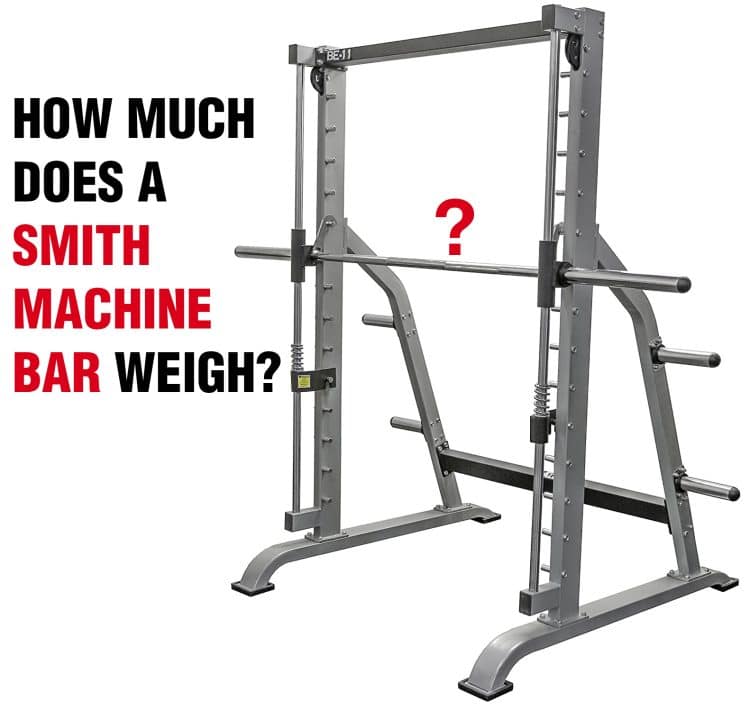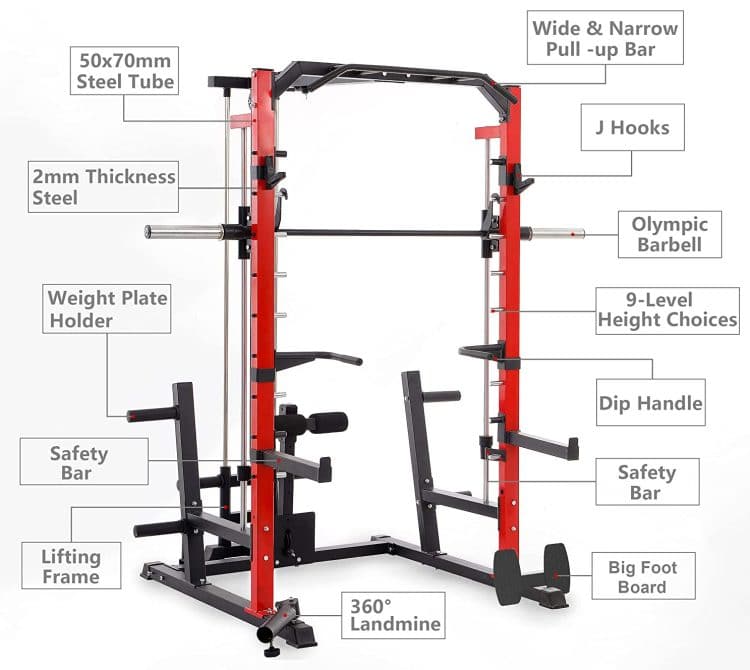The Smith machine bar weight varies by gym, but it is usually 7-30 pounds (3.1-13.6 kg). Some bars may be heavier or lighter depending on the Smith machine model and manufacturer.
Many lifters make a critical mistake while using a Smith machine. They have no clue how much the bar weighs. Some exercisers assume the Smith machine barbell weighs 45 pounds, while others disregard its weight. Both these approaches are faulty. Miscalculating or overlooking the bar’s weight can hamper your performance and lead to an injury.
To make matters worse, different Smith machine brands use different barbells and mechanisms, influencing the bar weights. The bar’s weight can also change with the equipment’s brand and price.
This article discusses everything you need to know about the Smith machine to get the best bang for your buck.
How Much Does a Smith Machine Bar Weigh?
The Smith machine bars can weigh somewhere between 7 pounds and 30 pounds depending on the material type, counterbalancing, construction, and angle of the rails.
To figure out how much the Smith machine bar at your gym weighs, you need to assess the mechanics of the machine.
Level Up Your Fitness: Join our 💪 strong community in Fitness Volt Newsletter. Get daily inspiration, expert-backed workouts, nutrition tips, the latest in strength sports, and the support you need to reach your goals. Subscribe for free!
In this article, you will find the bar weights of some of the most common Smith machines used in commercial and home gyms and also a way to reliably weigh the Smith bar you have access to at your home or gym.
Tip: If you’re unsure about the weight of your Smith bar, you should begin by checking for a label on the machine, as many brands label the weight of the bar on the side of the equipment. Nonetheless, you will find the bar weight of most big-name Smith machine brands on this list.
Related: Barbell Weights: Learn How Much Barbells Weigh
Two Different Types of Smith Machines
Smith Machines can be categorized into two sections — residential and commercial. Here are the main differences between the two:
| Characteristics / Type | Residential | Commercial |
| Linear | Perfectly Linear | Angled (0-12 degrees) |
| Counterbalance | No | Yes |
| Gliding System | Bush | Bearing |
| Sleeves | 1-2-inch sleeves | 2-inch sleeves |
| Bar Weight | ~30 pounds | 6-25 pounds |
1. Residential Smith Machines
Residential Smith machines are bare-bone machines with a barbell attached to two vertical pillars. These machines have a smaller footprint than commercial Smith machines and can fit into compact garage gyms. Home Gym Smith machines usually have a maximum weight capacity of 400 pounds.
- Angle: Perfectly linear
- Counterbalance: No
- Glide System: Bushing
- Bar Sleeve Diameter: 1-inch or 2-inch
- Bar weight: 30+ pounds
2. Commercial Smith Machines
These Smith machines look like power racks and have four pillars. Commercial Smith machines come in different shapes and sizes. The versatility of this equipment depends on its price tag. Commercial Smith machines are heavy-duty and can handle 600 to 1,000 pounds.
- Angle: 0-12 degrees
- Counterbalance: Yes
- Glide system: Bearing
- Bar Sleeve Diameter: 2-inch
- Bar weight: 6-52 pounds
Bar Weights of Different Smith Machines
Below are the bar weights of some of the most popular Smith machine brands —
| Brand | Bar Weight |
| Hammer Strength | 30 pounds |
| Matrix | 25-44 pounds |
| Body-Solid Residential | 6 pounds |
| Legend | 25 pounds |
| Nautilus | 15 pounds |
| Tuff Stuff | 10 pounds |
| Body-Solid Commercial | 32 pounds |
| Planet Fitness | 15-35 pounds |
| LA Fitness | 15-25 pounds |
| Marcy Smith | 16-36 pounds |
| Body Solid | 6-32 pounds |
| Hoist Smith | 25-52 pounds |
| Force USA | 45 pounds |
How To Measure A Smith Machine Bar Weight Yourself
If you cannot find the weight of your Smith machine bar on a label, on the list above, or on the manufacturer’s website, there are three ways to measure the bar weight yourself:
1. Bathroom Scale
You could determine the Smith bar’s weight with a bathroom scale using two methods —
Option 1
- Step one — Place the weighing scale on an even surface and weigh yourself.
- Step two — Set up the weighing scale on the floor under the Smith bar. There should be no weight plates on the bar sleeves.
- Place the barbell on your shoulders and step onto the scale.
- Record the total weight.
- Step three — Subtract the number received in step one from the number on the scale in step two. The result will be the exact weight of the Smith machine bar.
Option 2
This option is even easier. All you need are a plyobox and a weighing scale. The box is used to bring the scale in the Smith bar’s range of motion as it generally has several inches of free space from the floor to where the bar’s lowest position starts.
- Place the box directly under the Smith bar.
- Place the scale on the box, and then bring the bar down to the scale and let it rest on it.
- The reading on the scale is the weight of the Smith bar.
2. Hanging Scale
This is probably the easiest, most convenient, and most accurate way to measure a Smith bar’s weight. All you need for this is a hanging scale, also known as a fish scale.
Wrap the hanging scale’s strap around the bar, hook the strap to the hanging scale, and hang the bar from the scale to get its total weight.
3. Rope and Plates
Here is how to measure the weight of a Smith machine bar using a rope and plates —
- Tie one end of a thin rope around the middle of the Smith machine barbell and throw the other end over the crossbar (top bar).
- Set the bar at your chest level and hook it in place.
- The loose end of the bar should be near or touching the floor.
- Tie some weight plates to the loose end of the rope and unhook the bar to see if it balances with the weighted end of the rope. Think of it as a balancing scale.
- Keep changing the weight on the loose end of the rope until the weight and bar balance.
Related: Smith Machine Squat Alternatives for Powerful, Muscular Legs
Factors Affecting Smith Bar Weight
The following factors contribute to a bar’s weight:
1. Bar Material
Smith bars are made with a different type of steel compared to the Olympic barbells. Olympic barbells are designed and built using high-strength (and heavy) steel as they have to handle extremely heavy weights and need to have a whip (flex) to them.
Smith bars are a different ball game altogether. The steel rails, bearings, clamps, and slides reduce direct stress placed on the Smith bar. It also reduces the need for the bar to be as heavy as Olympic barbells.
Although a Smith machine bar does not have the same tensile strength as an Olympic barbell, it can generally handle the same weights as the conventional bar. Most commercial Smith machines have a 600-1000-pound max capacity, which is right on par with Olympic barbells.
When it comes to the length of the bars, most Smith bars have the same seven feet length as their Olympic counterparts. However, the diameter of the bars can vary depending on their utility.
While most Olympic and Smith bars have two-inch sleeves, some less-expensive residential-style Smith machines have one-inch sleeves. Notably, some Smith machines use an Olympic barbell.
2. Counterbalance
Some Smith machines use counterbalances, meaning even if the weight of the Smith bar is 40 pounds, the counterbalance mechanism will set off some of it. [5]
Most fancy gym chains use a counterbalanced Smith machine. On the other hand, more budget-friendly home gym Smith machines usually don’t have a counterbalance.
What is a counterbalance, and how does it work?
A Smith machine counterbalance works like a balancing scale. The bar is on one side of the machine, and the weights are on the other (generally concealed).
The Smith bar always weighs more than the counterweight. For example, if the bar weighs 40 pounds, the set of weights on the other end will weigh 20. This makes the bar feel lighter, especially on the concentric part of the movement — the upward movement while returning to the starting position during a squat.
To experience the phenomenon, try squatting or bench pressing with an empty Smith bar. You will feel that the bar flies up the top of the Smith machine at the slightest touch. [6]
Each manufacturer has a different way of counterbalancing the Smith machine.
3. Angle of the Rails
While some Smith machines have vertical steel rails for near-vertical movement patterns, others come with a slight incline. The angeled rails mimic the natural movement path for compound exercises like the squat, bench press, and shoulder press.
Commercial Smith machines generally have a seven to 12-degree incline, whereas most residential Smith machines move straight up and down. While the slight incline offers a more natural movement pattern, it also impacts the weight of the bar. Vertical Smith machines will put the highest resistance on your target muscles.
Notably, the impact of the incline on the bar’s weight is close to minimal. For example, a 12-degree incline may only make the Smith machine bar feel one to two pounds lighter.
What is a Smith Machine?
A Smith machine is one of the most common resistance training equipment. It consists of a barbell fixed within steel rails, allowing only vertical or near-vertical movement.
A Smith bar has two hooks, one on each side, that lets you latch the bar on a series of lockout points. A Smith machine is used by beginner, intermediate, and advanced lifters alike.
Level Up Your Fitness: Join our 💪 strong community in Fitness Volt Newsletter. Get daily inspiration, expert-backed workouts, nutrition tips, the latest in strength sports, and the support you need to reach your goals. Subscribe for free!
It is one of the most effective training equipment. However, it routinely gets flake from the hardcore strength sports community for being a machine generally used by weak and lazy lifters. But why does the Smith machine get so much hate, you ask?
Smith machines come in various shapes and sizes. But before we get into the nitty-gritty of how much a smith machine bar weighs, let’s talk a little about the machine, shall we?
Have you ever wondered why the versatile training tool is called a “Smith” machine and how it came to be?
An American fitness and nutrition guru, Jack LaLanne, in the 1950s invented the original model of what became the Smith machine. He rigged up a sliding apparatus in his gym in the 1950s. LaLanne also designed the first leg extension machines, pulley machines using cables, and weight selectors that are now standard in the fitness industry.
Rudy Smith spotted LaLanne’s ingenious invention and commissioned Paul Martin to improve it. Smith installed the new and improved model in a gym he was managing — Vic Tanny’s gym in Los Angeles, CA. By the late 1950s, Smith became an executive in Tanny’s chain of gyms, and the Smith machine was being manufactured and sold in gyms around America.
Related: Dumbbells, Barbells, Or Smith Machines For Maximum Muscle?
Parts of a Smith Machine
The parts of a Smith machine might change depending on its brand, model, and price. These are the most common Smith machine components:
- Steel Tube: These make up the Smith machine’s body.
- Olympic Barbell: The Smith machine barbell allows you to use appropriate poundage.
- Safety Pins: Different Smith machines have varying numbers of safety pins that allow you to rack the weight at multiple points through the range of motion.
- Latches: A Smith machine barbell has pegs on each side that allow you to rack the bar on the safety pins.
- J Hooks: Some Smith machines come with J hooks that allow you to use the machine as a barbell rack.
- Safety Bar: Safety bars on a Smith machine are usually an accessory used while performing free-weight barbell squats or as a rack for barbell exercises like the bent-over row.
- Pull-Up Bar: The Smith machine pull-up bar is a clever use of the overhead steel tube.
- Lifting Frame: Some Smith machines have a lifting frame attached to the rear that allows you to stack weight plates for exercises like the cable lat-pulldown, triceps push-down, etc. You might need cable pulley handles to use the lifting frame.
- Dip Handles: These accessories attach to the safety pins and allow you to perform bodyweight or weighted dips.
- Weight Plate Holder: Smith machines usually come with weight plate holders.
- Landmine: The landmine attaches to the bottom of the steel tube for exercises like the T-bar row, Meadows row, etc.
- Big Foot Board: Some Smith machine power cages come with a big footboard for exercise like lat-pull-down, cable rows, etc.
What is the Purpose of a Smith Machine?
The Smith machine is a weight training tool a lifter can use to build strength and muscle mass. You should go heavy on the Smith machine and stay in the 1-5 rep range if your goal is to build strength. Alternatively, performing 8-12 reps puts you in the sweet spot for inducing hypertrophy.
Why are Lifters Critical of the Smith Machine?
Although the Smith machine is just a barbell attached to a safety rail system which makes lifting safer, it gets a bad rap for three reasons. First, since the Smith machine is attached to a rail on either side, it alters a lifter’s natural movement pattern by limiting forward-backward movement and controlling the bar for them. Studies have also shown that free weights can be more beneficial for strength and muscle building than a Smith machine. [1]
Plus, while lifting heavy on a Smith machine, a slight mistake can put unnecessary tension on your joints, putting you at risk of an injury.
Secondly, free weights like barbells and dumbbells have an element of risk attached to them. Lifting extremely heavy using a barbell is like riding a rollercoaster without a seatbelt — you could get hurt, but for most lifters, the thrill is well worth it. [2]
On the other hand, a Smith machine acts as your personal spotter. While it is one of the biggest benefits of using the machine, especially for people who train alone, it also brings backlash. [3]
The Smith machine bar is attached to a rail system and has pegs every couple of inches where you can lock the bar in place and get out safely in case you fail during a rep. [4]
Finally, most Smith machines come with a counterbalance — meaning the machine helps you in the concentric part of the lift. Additionally, the counterbalance and, ultimately, the Smith bar weight can vary depending on the manufacturer and model of the equipment.
Three 45-pound weight plates on each end of a Smith machine bar sleeve do not necessarily equal 315 pounds. Unlike the seven feet 45-pound Olympic barbells, some Smith machine bars (with counterbalance weights and angled motion) can weigh between 6 to 52 pounds.
Check Out: Free Weight Barbell Squat Vs. Smith Machine Squat: Which Is Better For Gains?
Smith Machine vs. Free Weights: Which Are Better?
Comparing the Smith machine to free weights is an apples and oranges comparison. The Smith machine barbell follows a fixed vertical trajectory. In contrast, you can use a free-weight barbell to perform exercises that follow curved movement patterns besides vertical movement patterns.
Smith Machine is Better For Lifters Who Train Alone
The free-weight barbell is a more versatile training equipment than the Smith machine. The Smith machine, however, is a better option for people who train alone, as the multiple safety pins allow you to track the weight if you fail during a rep.
A Smith Machine Uses Additional Friction
The bearing inside the Smith machine barbell carriage adds friction while sliding up and down the steel guide rods. The friction keeps you from going too fast while performing exercises on the Smith machine, which can help increase your time under tension.
On the flip side, you might prefer a free-weight Olympic barbell if you are training for explosive strength.
Smith Machines Eliminate Your Stabilizers
A Smith machine follows a fixed movement pattern, which leads to the elimination of your core stabilizers. Smith machines might be great for beginners learning the basics of lifting. Experienced lifters, however, should avoid using it too frequently if they want to improve their core strength.
You Can Limit Your Range of Motion on a Smith Machine More Effectively
Safety pins on a Smith machine allow you to limit your range of motion. Working with a restricted range can be incredibly helpful for people who want to focus on a troubled area or folks dealing with injuries.
Although you could limit your range of motion on a free-weight barbell, it is less effective than the Smith machine.
Since the Smith machine and free weights have unique pros and cons, you must choose between the two depending on your needs and preferences. You should, however, alternate between the two to get the best of both worlds.
FAQs
Should I consider the bar weight while using the Smith machine?
Make no mistake, a Smith machine’s bar weight is true weight. The Smith bars weigh between 6 to 52 pounds, and there is no reason why you shouldn’t consider them.
Pro tip: You should only compare your Smith machine PRs with other Smith machine PRs. Even though the Smith machine bar is true weight, the fixed movement pattern, friction, and counterweight make exercises easier. To put it briefly, a 405-pound squat on the Smith machine does not equal a 405-pound squat using an Olympic barbell.
Is knowing the bar weight while using a Smith machine necessary?
Would you lift a dumbbell for a working set without knowing how much it weighs? Knowing the bar weight is important if you want to build muscle mass and strength by progressively overloading your muscles. Knowing the bar weight can also help you figure out your starting weight on the first set of an exercise more accurately.
Do Mr. Olympia champions use a Smith machine?
This is a common question — and a legitimate one too. Mr. Olympia champs are considered the best bodybuilders in the world. Bodybuilding and fitness aficionados follow their diets and training routines closely. An endorsement by the bodybuilding titans can certainly make their followers use the machine.
The three-time Classic Physique Olympia champion, Chris Bumstead, calls the Smith machine a “godsend” and incorporates it in almost all his workouts. If a Mr. O. winner swears by the Smith machine, what is stopping you from adding it to your workouts?
Is the Smith machine bench press as effective as the barbell bench press?
Although the Smith machine bench press and barbell bench press might look the same at first glance, they have intricate differences. The Smith machine bench press bar travels through a fixed trajectory — vertically or at a slight angle. On the flip side, the free-weight bar moves through a slight angle.
In a barbell bench press, most lifters hold the barbell above their upper pecs at the static contraction point at the top. They then lower the bar at a slight angle and touch it with their chest at the nipple level. Using this movement pattern can help achieve better muscle contraction.
Although an angled Smith machine can replicate this range of motion, it lacks in one key area — core stabilizer recruitment. Free weights help strengthen your core, which can carry over to other functional movements.
Is the Smith machine bar considered true weight?
Irrespective of the friction, counterbalance, angled movement pattern, and bearings, the Smith machine bar weight is true weight and is calculated keeping all these factors in mind.
Since a Smith machine bar can weigh between 6 and 52 pounds, you should always consider its weight while adding weight to the barbell. Ignoring the bar weight can lead to an injury, especially while attempting personal bests, as you might be using more weights than you can handle safely.
You can use one of the three techniques mentioned in this article if the Smith machine at your gym doesn’t say its weight. Also, as a benevolent gesture, write the bar’s weight on its sleeve so that other lifters at your gym can benefit from it. You should, however, seek your gym management’s permission before performing this noble act.
Why does a smith machine bar feel lighter?
The Smith machine barbell uses counterbalance and friction and moves at an angle, which can make the bar feel lighter. As a result, a 315-pound bench press on the Smith machine might feel lighter than a 315-pound bench press using free weights.
It is common for lifters to have different PRs on the same exercise on the Smith machine and free weights. For example, a lifter might have a 315-pound free-weight squat PR and a 335-pound Smith machine PR. The Smith machine PRs are generally heavier than free weight bests.
You shouldn’t go heavier on the Smith machine than free weights from the get-go. Use the same progression on the Smith machine as the free weights and increase the poundage only after you have developed a knack for the Smith machine.
Next Read: The 18 Best Smith Machine Exercises
Wrapping Up
Smith machines are seeing wide adoption in professional training routines, and many lifters turn to the training equipment to achieve better muscular stimulation and pumps.
A smith machine also reduces a bodybuilder’s chances of getting injured during training by stabilizing the lift. To sum it up, the pros of using a Smith machine far outweigh the cons, and you should absolutely include it in your training regimen.
References
- Schwanbeck, Shane; Chilibeck, Philip D; Binsted, Gordon A Comparison of Free Weight Squat to Smith Machine Squat Using Electromyography, Journal of Strength and Conditioning Research: December 2009 – Volume 23 – Issue 9 – p 2588-2591 doi: 10.1519/JSC.0b013e3181b1b181
- Cotterman ML, Darby LA, Skelly WA. Comparison of muscle force production using the Smith machine and free weights for bench press and squat exercises. J Strength Cond Res. 2005 Feb;19(1):169-76. doi: 10.1519/14433.1. PMID: 15705030.
- Schick EE, Coburn JW, Brown LE, Judelson DA, Khamoui AV, Tran TT, Uribe BP. A comparison of muscle activation between a Smith machine and free weight bench press. J Strength Cond Res. 2010 Mar;24(3):779-84. doi: 10.1519/JSC.0b013e3181cc2237. Erratum in: J Strength Cond Res. 2011 Jan;25(1):286. PMID: 20093960.
- Hughes LJ, Peiffer JJ, Scott BR. Load-velocity relationship 1RM predictions: A comparison of Smith machine and free-weight exercise. J Sports Sci. 2020 Nov;38(22):2562-2568. doi: 10.1080/02640414.2020.1794235. Epub 2020 Jul 15. Retraction in: J Sports Sci. 2021 Aug;39(16):1910. PMID: 32669051.
- Design of trajectories and torques by parameter optimization for the bench press exercise on a Smith machine. Mechanism and Machine Theory, 155, 104089. https://doi.org/10.1016/j.mechmachtheory.2020.104089
- Vingren, J.L., Buddhadev, H.H., & Hill, D.W. (2011). Smith Machine Counterbalance System Affects Measures of Maximal Bench Press Throw Performance. Journal of Strength and Conditioning Research, 25, 1951-1956.














